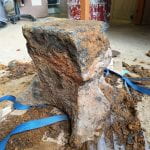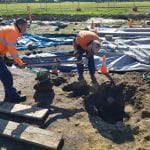We’re well and truly getting into it now. For the last few weeks attention has turned to the western portion of the site, where a layer of clay and some patches of burning indicated that we were getting close to (or indeed on) deposits associated with the foundry.

We don’t just use trowel and bucket. Here you can see the dizzying amount of crap we have to lug around with us: drawing equipment, survey gear, recording tablets and forms, cameras, drawing boards, artefact bags and tags. At least 20 mins is spent every day moving this stuff in and out of the trailer.
Richard has been working in the north part of the area. A poured mortar floor has been uncovered, on which we think a casting furnace may have been situated (the ca.1863 plan shows one in this area). To the east of this, we are finding a series of brick footings and a brick surface, as well as thick patches of charcoal and mortar rubble. Though we are currently unsure as to what it means, we are potentially looking at some early features (possibly 1830s) that were related to the shoemakers’ workshop. These have been damaged by later works in the area, likely as part of the ca.1854-57 modifications to the building.
As part of this, Richard has been cutting a series of deep slots across the area to try and work out the confusing stratigraphy. A small slot was excavated near the footings (see piccy above), which found that they are set on and cut into a thick (>0.70m) layer of reclamation clay. This likely dates from the earliest years (early 1830s). Another two slots have also confirmed that there is a line of disturbance running right through the middle of the site, formed when an early footing (or other stone linear feature) was removed – potentially around the time the building was modified ca.1854-57. This left a deep linear pit, which had been backfilled with a confusing array of silt and rubble. These slots have also encountered the thick layer of clay, as well as large dolerite boulders – highly likely to be the reclamation material on which the workshops are set. In two of the slots we have also found large timbers, which would have been the cribbing in which the clay was situated.
Sylvana has been at work in the southern part of the area, trying to decipher the confusing array of burn marks and charcoal on the yellow clay. It looks like this might have been an area where some more portable furnaces/forges may have been standing during the foundry period. Like in Richard’s area, Sylvana has also excavated some small trenches to see what the stratigraphy below looks like. This shows that there is a layer of demolition debris (brick, mortar and artefacts) below the clay, as well as potentially a fine layer of silt (a possible occupation deposit). We currently think these layers are from the 1830s/40s occupation period.
Finally, next week – as part of National Archaeology Week – we will be putting up a story on this blog about a pretty damn cool artefact that we recovered last week. I don’t want to give too much away, but it was sitting in a pit in the middle of the foundry. Finding it was unexpected, but we’ve got some theories as to why it ended up where it did. Stay tuned for more next week!






